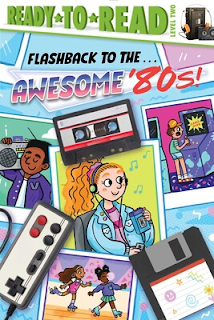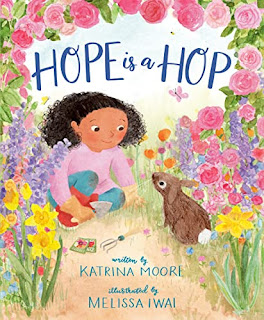Today's rundown is a list of recently published books about nature, appropriate for Earth Day or any day.

How Old is a Whale? Animal Life Spans from the Mayfly to the Immortal Jellyfish by Lily Murray, illustrated by Jesse Hodgson
*Review copy courtesy of Candlewick Press
Writing: Though this book is in picture book format, the text is at the middle grade level. Each section describes the life cycle of a specific species, including details of when in their lives they begin to move, mate, hibernate, etc. The book begins with the shortest lifespan (5 minutes to 24 hours for the adult mayfly) and continues through progessively longer lifespans, ending with the ocean quahog (400 years), the glass sponge (11,000 years), and the immortal jellyfish which regenerates and never dies. It's a fascinating way to organize animals, and it puts the natural world into perspective in a way I hadn't even considered before. Though the table of contents does make it pretty easy to look up a specific animal, I think this is more of a book to read for fun than a resource for research.
Illustration: The detailed colored pencil drawings fill every page and they capture the various phases of life for each creature, as well as the habitats in which they live and how they move and eat. The drawings are realistic scientific drawings, but they feel like pieces of art, not just diagrams. The book is very visually appealing and will draw in animal lovers easily.
Content: I appreciate that this book keeps the emphasis on non-human animals, and leaves the discussion of human mortality out of it. I think it's more comfortable for kids to contemplate the often-short lifespans of animals when they're not also thinking about the fact that the people they love will die someday. I also like the detached tone of the writing; animal deaths are treated as facts of science and nature (which is what they are) and not as sad events requiring an emotional response.
Overall: This is an excellent informational book for elementary readers that would pair well with other titles about interesting animal facts, such as Actual Size.

This is the Planet Where I Live by K.L. Going and Debra Frasier
*Review copy courtesy of Beach Lane Books.
Writing: This celebration of planet Earth is written in the style and format of The House that Jack Built. It begins with us, human beings, then our homes and fields, followed by the creatures and plants that make our life on Earth possible. There is a gentle rhyme scheme that makes the repetition feel very pleasant and begs for the text to be read aloud. It's deceptively simple, but it's clear the author was very deliberate in her word choice.
Illustration: The abstract illustrations incorporate silhouettes of people and animals, actual blooms and stems and insects from nature, and beautiful swirling lines to suggest the cyclical nature of life on Earth. The pictures are bright and engaging, filled with details to reward the careful observer, but also large and bold enough to translate well to a story time audience. The pictures embody the joyful, celebratory tone of the text.
Content: This is a love letter to the planet that does not preach. It emphasizes the inter-connectedness of all life on Earth, but steers clear of agenda-driven rhetoric that sometimes creeps into children's books about nature. It's a beautifully-designed age-appropriate book to help young children learn to love our Earth. (It does not mention a Creator, but it would be easy for religious readers to extrapolate to a religious discussion of who made all these things.)
Overall: I am a picture book skeptic most days, but this is a real gem. I really enjoyed it, and I think my kids will too.
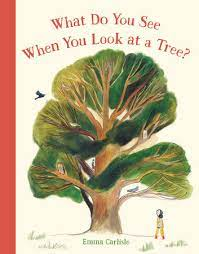
What Do You See When You Look at a Tree? by Emma Carlisle
*Review copy courtesy of Templar.
Writing: Rhyming text invites the reader to observe trees, then consider their feelings. Non-rhyming back matter then encourages the reader to think about ways to be more like trees.
Illustration: The color scheme of the pictures creates an earthy, naturalistic feel. The trees are artistic renderings rather than scientific diagrams, and the figures are fairly cartoonish. There are several sweet pictures of a family enjoying time together under a tree.
Content: This is the kind of nature book I actively avoid. Ascribing human emotions to trees and encouraging kids to think of trees as their friends is confusing and it romanticizes conservation in a way that feels manipulative. We need to care for Creation because it's good for us, and it's good for our planet, not because trees' feelings might be hurt.
Overall: This is an attempt to make kids care about the enviroment by appealing to feelings of guilt instead of feelings of responsibility. It's a weird take on the subject matter and will not be staying in our home.

The Tree and the River by Aaron Becker
*Review copy courtesy of Candlewick Press.
Writing: This is a wordless book, but the jacket copy tells us we are in either an alternate past or a potential future The story follows the same scene over a period of many years, showing a timelapse of the development of civilization and the changes industrialization brings to the natural world.
Illustration: The pictures are very interesting because they portray the exact same scene, making major leaps forward in time with each turn of the page. The tree and river mentioned in the title remain in place throughout the book, and the changes they undergo represent the impact on the natural world of the human technological advances depicted by the surrounding scene. There is a lot of detail in each picture, and the scenes invite the reader to think about what is happening in each new epoch and how this is impacting nature.
Content: I was afraid this was going to be a doom-and-gloom book, and I'm relieved to say it isn't. Because there are no words, there is no room for the author to guide the reader's thoughts. Rather, the reader can observe and draw his/her own conclusions. The final images of the book also portray a hopeful message, that if we go too far in our development of technologies, all is not lost and we can correct our course and start again. It also hints at the cyclical nature of all things on Earth.
Overall: This is a beautifully illustrated book and it invites kids to think without telling them how to do it. I appreciate that, and I really enjoyed paging through this one.
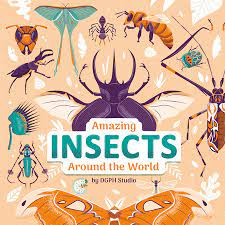

Amazing Insects Around the World by DGPH Studio
Amazing Animals Around the World by DGPH Studio
*Review copies courtesy of Penguin Workshop.
Writing: These are informational books, and they are written similarly to a textbooks in that unfamiliar words are bolded and the author uses a straightforward, just-the-facts style. I wouldn't say the writing is dry per se, but it's direct and informative. There are sidebars and informational boxes in the margins of the pages, as well as labels identifying the different creatures that appear in the pictures.
Illustrations: The pictures are highly stylized digital drawings that are both useful as scientific diagrams and appealing to look at just as artwork. The images are organized well on the page so that even where this a lot of visual information it isn't overwhelming to the eye. Bold, capitalized headlines help the text stand out amidst the illustrations, which makes the amount of reading on each spread feel manageable too.
Content: These are good resources for a first research project, as there is a table of contents and glossary in each, and the information presented is of the type typically requested by an early elementary school science report. The insect volume is a bit more general, and the animal one puts more of an emphasis on unusual animal characteristics, but both are solid general biology titles.
Overall: I requested these with my 3-year-old son in mind, as he loves nonfiction and especially enjoys books with a lot of pictures. I don't think he will be disappointed. We probably have enough biology titles to last all of our homeschooling days, but if you are building up a collection, these aren't bad at all.

One World: 24 Hours on Planet Earth by Nicola Davies, illustrated by Jenni Desmond
*Review copy courtesy of Candlewick Press.
Writing: Like many books have done before, this one follows animal activity on Earth over the course of one day to emphasize biodiversity. I only requested it because the author is Nicola Davies and her science books tend to be a notch above the rest. She takes a conversational kid-friendly tone in this one, inviting the reader to observe various things in the different places the book visits. Each page's blurb is short, but well-written and engaging to read. She does, however, emphasize negativity, as she cautions about all the ways humans may be destroying the Earth and suggests that certain solutions are simple without getting into the nuance of those solutions.
Illustrations: The illustrator portrays a pair of children in each scene who act as the readers' guides through the book. Since these human characters travel to places that are uninhabitable, this adds a whimsical fantasy element to the book that makes the journey feel fun and magical. The illustrations do a beautiful job of emphasizing the beauty of various aspects of nature and of helping the reader imagine the weather conditions of each climate.
Content: The problem with simplifying a topic for a children's book is that it can make the problem look simple. In at least a few places, the author indicates that a plan exists for fixing a certain problem, if only we would just follow that plan, as though there are no disagreements or politics standing in the way. We did kids a disservice when we introduce them to topics they aren't ready to handle in full and try to win them over to a certain way of thinking by leaving out some of the facts. I wouldn't quite put this in the propaganda category, but I would definitely instruct my kids to consider bias if they read this one.
Overall: I think there are books that handle this topic better and with less problematic content, but this one is mostly an admirable addition to this genre.
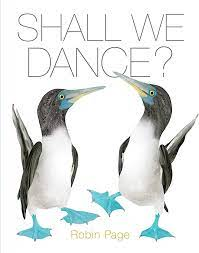
Shall We Dance? by Robin Page
*Review copy courtesy of Beach Lane Books.
Writing: This picture book explores animal dances, not just for courtship but also for communication and transportation. Each page describes a different creature's dance moves and their purpose. Large, bold text in various colors gives a one-sentence description of the animal's movement, and then a blurb in smaller text expands upon that information in a child-appropriate style.
Illustration: Each page shows an oversized animal or pair of animals against either a white background (for land animals) or an ocean backdrop (for sea animals.) The creatures and their movements are the main focus of each page, and even the text is made small to accomodate them. The artist does a beautiful job of portraying animals as they would look in real life, and of capturing their signature moves. (Page is the wife of Steve Jenkins, and readers who know What Do You Do With a Tail Like This? will recognize her style from their collaboration on that book.)
Content: This is an appealing look at an interesting aspect of nature. It can be read to a preschooler using just the simplified sentence on each page, or it can be a more detailed exploration for an early elementary reader. It's definitely a book to read for fun, not so much a reference source.
Overall: This is a visually appealing title on an engaging topic that young nature lovers will really enjoy.

Rain by Cynthia Rylant, illustrated by Lisa Congdon
*Review copy courtesy of Beach Lane Books.
Writing: This book is an extended description of the reactions of various animals and people before, during, and after a rainstorm. The text reminds me of certain books by Margaret Wise Brown, in that it feels a bit disjointed and I can't always tells where it's going next. It's not as poetic or distinctive as I would expect this author's writing to be.
Illustration: The pictures are digital illustrations that zoom in and out on various scenes inside and outside of a home. Colors fill every page, which is very appealing, and the raindrops really capture the feel of a rainy day.
Content: This is a story celebrating the need for rain. It's not particularly memorable, but it's fine. There is no hidden agenda in this book, and it's not about anything other than enjoying rain for the gifts it brings us.
Overall: Other books about rain are more interesting than this one, so this would be an additional purchase for most people, whether for home libraries or public ones.

Eric Loves Animals (Just Like You) by Eric Carle
*Review copy courtesy of Penguin Young Readers.
Writing: This book is essentially a visual dictionary of animals using the artwork of Eric Carle. The only real text in the book is the names of the animals depicted in the illustrations, which are organized alphabetically. A handful of times there are quotations from Eric Carle himself, but no other commentary at all.
Illustration: This is very much an art book, for fans of Eric Carle. My 5-year-old daughter is a huge Carle lover and she has spent hours poring over each page. It was thrilling for her to see a new book after his death. I think she likes having all this artwork to look back on even though he is no longer with us to produce anymore. It's fun to see the different ways he portrayed various animals using his signature technique.
Overall: This is a lovely tribute to a long career. It's a fun book for kids, but would also be a great coffee table book for a children's literature enthusiast of any age.

The Very Hungry Caterpillar's Garden Friends by Eric Carle
*Review copy courtesy of Penguin Young Readers.
Writing: This is a gently written board book that invites babies and toddlers to observe what's happening in a garden. My three-year-old twins ask me to read it multiple times a day.
Illustration: The pictures incorporate touch-and-feel elements that are very appealing to the youngest readers. The familiar caterpillar guiding the reader through the book also really engages them.
Overall: This book is the perfect choice for a young Eric Carle lover in your life.
 The Story of a Book by Joy McCullough and Devon Holzwarth
The Story of a Book by Joy McCullough and Devon Holzwarth











